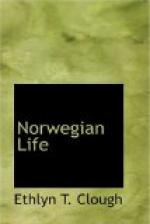Trondhjem itself is an odd place for festivities. The people say that it is fear of fire which makes them separate their insignificant wooden houses by such disproportionately broad streets. Certainly it gives to the town a low look anything but imposing.
Whatever may be the esthetic shortcomings of King Haakon’s coronation city, it was amply atoned for by the enthusiasm and whole-hearted devotion of his new people. The king and queen are in very truth “the father and mother of the land.” Even toward the rulers they shared with Sweden their cherished warm affection until their grievances waxed too sore. When Sophie of Nassau was on her way to Trondhjem to be crowned, in 1873, she drove herself in a carriole from the Romsdal, stopping perforce at humble posting-stations by the way. And everywhere the peasants came with flowers, greeting their queen by the affectionate and familiar “Du.” More than once when the press was thick about her, and those on the outskirts could not see, the queen was urged to mount upon the housetop that the eyes of all might be gladdened by the sight of the dear land-mother. There was a significant demonstration of this sort of heart-loyalty when Haakon VII and Queen Maud entered Christiania. The crowds which waited in the steadily falling snow, and shouted themselves hoarse, might be accounted for by curiosity and mob enthusiasm.
Triumphal arches, flags, and even the rain of flowers which descended on the royal pair, might be classed as perfunctory, an essential part of the occasion. But at night the spirit of the people showed beyond mistake. Not only were the streets arched and bordered with festoons of colored incandescent lights, not only were the battleships in the harbor strung with fiery beads to the topmost spar, but every window in every house in the city bore its light. Fine houses had candelabra behind the glass, and the poorest mere tapers, but everywhere the same fire of welcome burned.
Haakon VII has the privilege of ruling over the most united people on the face of the earth. Before the plebiscite, Sweden declared that the desire for separation was confined to a party who were poisoning the minds of the common people. When the plebiscite had shown that only 164 men out of 368,000 could be found to uphold the union, Sweden protested that the peasants had been intimidated and dared not vote as they thought!




